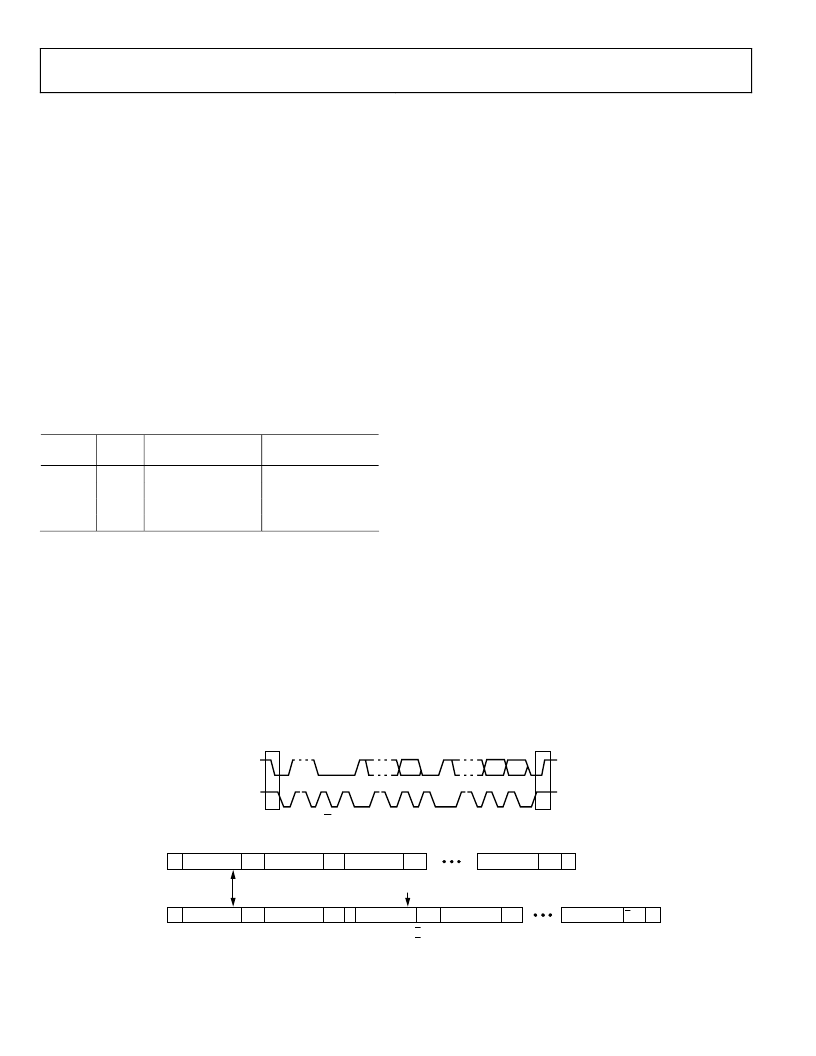- 您現在的位置:買賣IC網 > PDF目錄378286 > ADV7183AKST (ANALOG DEVICES INC) Multiformat SDTV Video Decoder PDF資料下載
參數資料
| 型號: | ADV7183AKST |
| 廠商: | ANALOG DEVICES INC |
| 元件分類: | 顏色信號轉換 |
| 英文描述: | Multiformat SDTV Video Decoder |
| 中文描述: | COLOR SIGNAL DECODER, PQFP80 |
| 封裝: | LEAD FREE, MS-026-BEC, LQFP-80 |
| 文件頁數: | 64/104頁 |
| 文件大?。?/td> | 894K |
| 代理商: | ADV7183AKST |
第1頁第2頁第3頁第4頁第5頁第6頁第7頁第8頁第9頁第10頁第11頁第12頁第13頁第14頁第15頁第16頁第17頁第18頁第19頁第20頁第21頁第22頁第23頁第24頁第25頁第26頁第27頁第28頁第29頁第30頁第31頁第32頁第33頁第34頁第35頁第36頁第37頁第38頁第39頁第40頁第41頁第42頁第43頁第44頁第45頁第46頁第47頁第48頁第49頁第50頁第51頁第52頁第53頁第54頁第55頁第56頁第57頁第58頁第59頁第60頁第61頁第62頁第63頁當前第64頁第65頁第66頁第67頁第68頁第69頁第70頁第71頁第72頁第73頁第74頁第75頁第76頁第77頁第78頁第79頁第80頁第81頁第82頁第83頁第84頁第85頁第86頁第87頁第88頁第89頁第90頁第91頁第92頁第93頁第94頁第95頁第96頁第97頁第98頁第99頁第100頁第101頁第102頁第103頁第104頁

ADV7183A
MPU PORT DESCRIPTION
The ADV7183A supports a 2-wire (I
2
C compatible) serial inter-
face. Four inputs, serial data (SDA1 and SDA2) and serial clock
(SCLK1 and SCLK2), carry information between the
ADV7183A and the system I
2
C master controller. Each slave
device is recognized by a unique address. The ADV7183A has
two ports: the control port, which allows the user to set up and
configure the decoder; and the VBI data readback port, which
allows the user to read back captured VBI data. Both the control
and VBI ports have four possible slave addresses for both read
and write operations, depending on the logic level on the ALSB
pin. These four unique addresses are shown in Table 170. The
ADV7183A’s ALSB pin controls Bit 1 of the slave address. By
altering the ALSB, it is possible to control two ADV7183As in
an application without having a conflict with the same slave
address. The LSB (Bit 0) sets either a read or write operation.
Logic 1 corresponds to a read operation; Logic 0 corresponds to
a write operation.
Table 170. I
2
C Address for ADV7183A
Slave Address
Control Port
0
0
0x40
0
1
0x41
1
0
0x42
1
1
0x43
Rev. A | Page 64 of 104
ALSB
R/W
Slave Address
VBI Port
0x20
0x21
0x22
0x23
To control the device on the bus, a specific protocol must be
followed. First, the master initiates a data transfer by establish-
ing a Start condition, which is defined by a high-to-low
transition on SDA1/SDA2 while SCLK1/SCLK2 remains high.
This indicates that an address/data stream will follow. All per-
ipherals respond to the Start condition and shift the next eight
bits (7-bit address + R/W bit). The bits are transferred from
MSB down to LSB. The peripheral that recognizes the trans-
mitted address responds by pulling the data line low during the
ninth clock pulse; this is known as an acknowledge bit. All other
devices withdraw from the bus at this point and maintain an
idle condition. The idle condition is where the device monitors
the SDA1/SDA2 and SCLK1/SCLK2 lines, waiting for the Start
condition and the correct transmitted address. The R/W bit
determines the direction of the data. Logic 0 on the LSB of the
first byte means the master will write information to the
peripheral. Logic 1 on the LSB of the first byte means the master
will read information from the peripheral.
The ADV7183A acts as a standard slave device on the bus. The
data on the SDA pin is eight bits long, supporting the 7-bit
addresses plus the R/W bit. The ADV7183A has 196 subad-
dresses to enable access to the internal registers. It therefore
interprets the first byte as the device address and the second
byte as the starting subaddress. The subaddresses auto-
increment, allowing data to be written to or read from the
starting subaddress. A data transfer is always terminated by a
Stop condition. The user can also access any unique subaddress
register on a one-by-one basis without updating all the registers.
Stop and Start conditions can be detected at any stage during
the data transfer. If these conditions are asserted out of
sequence with normal read and write operations, they cause an
immediate jump to the idle condition. During a given SCLK
high period, the user should only issue one Start condition, one
Stop condition, or a single Stop condition followed by a single
Start condition. If an invalid subaddress is issued by the user,
the ADV7183A will not issue an acknowledge and will return to
the idle condition.
If in auto-increment mode the user exceeds the highest
subaddress, the following action is taken:
1.
In read mode, the highest subaddress register contents
continue to be output until the master device issues a no-
acknowledge. This indicates the end of a read. A no-
acknowledge condition is where the SDA line is not pulled
low on the ninth pulse.
2.
In write mode, the data for the invalid byte is not loaded
into any subaddress register, a no acknowledge is issued by
the ADV7183A, and the part returns to the idle condition.
0
SDATA
SCLOCK
START ADDR
ACK
ACK
DATA
ACK
STOP
SUBADDRESS
1–7
1–7
8
9
8
9
1–7
8
9
S
P
R/W
Figure 36. Bus Data Transfer
0
S
WRITE
SEQUENCE
SLAVE ADDR
A(S)
SUB ADDR
A(S)
DATA
A(S)
DATA
A(S)
P
S
READ
SEQUENCE
SLAVE ADDR
SLAVE ADDR
A(S)
SUB ADDR
A(S) S
A(S)
DATA
A(M)
DATA
A(M) P
S = START BIT
P = STOP BIT
A(S) = ACKNOWLEDGE BY SLAVE
A(M) = ACKNOWLEDGE BY MASTER
A(S) = NO-ACKNOWLEDGE BY SLAVE
A(M) = NO-ACKNOWLEDGE BY MASTER
LSB = 1
LSB = 0
Figure 37: Read and Write Sequence
相關PDF資料 |
PDF描述 |
|---|---|
| ADV7330 | Multiformat 11-Bit Triple DAC Video Encoder |
| ADV7330KST | Multiformat 11-Bit Triple DAC Video Encoder |
| ADXL321 | Small and Thin 18 g Accelerometer |
| ADXL321EB | Small and Thin 18 g Accelerometer |
| ADXL321JCP | Small and Thin 18 g Accelerometer |
相關代理商/技術參數 |
參數描述 |
|---|---|
| ADV7183AKST-U1 | 制造商:Analog Devices 功能描述:VID DECODER 80LQFP - Bulk |
| ADV7183AKST-X2 | 制造商:Analog Devices 功能描述:VID DECODER - Bulk |
| ADV7183AXST | 制造商:Analog Devices 功能描述:VIDEO DECODER I.C. - Bulk |
| ADV7183AXST-X2 | 制造商:Analog Devices 功能描述:VIDEO DECODER I.C. - Bulk |
| ADV7183AXT | 制造商:Analog Devices 功能描述:VIDEO DECODER I.C. - Bulk |
發(fā)布緊急采購,3分鐘左右您將得到回復。